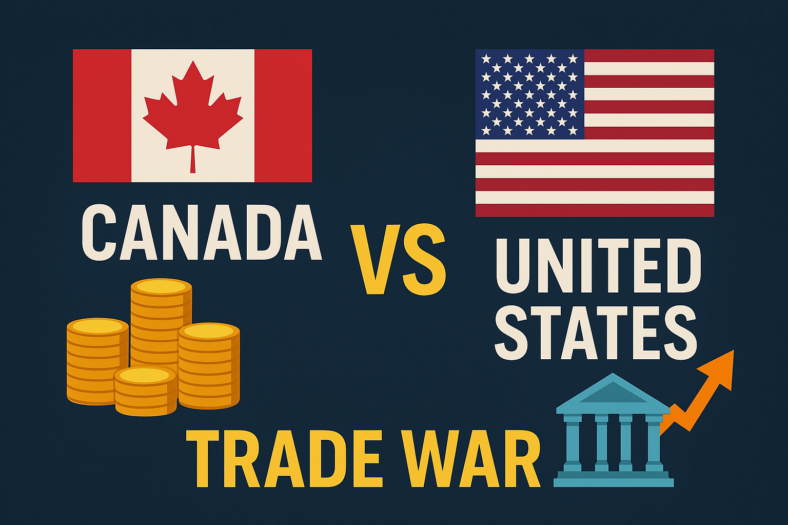In Canada, high-interest savings accounts (HISAs) have become increasingly popular among savers seeking to maximize their returns while maintaining liquidity and security. With interest rates fluctuating and traditional savings accounts offering minimal returns, HISAs stand out as a viable option for individuals and families looking to grow their savings without subjecting them to market volatility. These accounts typically offer interest rates significantly higher than those of regular savings accounts, making them an attractive choice for those aiming to build an emergency fund, save for a specific goal, or simply earn more on their idle cash. In this guide, we’ll delve into the nuances of high-interest savings accounts in Canada, exploring their benefits, considerations, and the top options available in the market.
Our Top Picks for the Best HISAs in Canada:
Types of high interest saving accounts
High-interest savings accounts (HISAs) come in various forms, each tailored to meet different financial needs and preferences. Here are some common types of HISAs you might encounter:
- Standard HISAs: These are the most common type of high-interest savings accounts offered by banks and financial institutions. They typically offer competitive interest rates that are higher than those of regular savings accounts, making them an attractive option for savers looking to earn more on their deposits while maintaining easy access to their funds.
- Online HISAs: Online high-interest savings accounts operate entirely online, with no brick-and-mortar branches. Because online banks have lower overhead costs compared to traditional banks, they can often offer higher interest rates on savings accounts. Online HISAs are convenient for those comfortable with digital banking and seeking competitive interest rates.
- Tiered HISAs: Tiered high-interest savings accounts offer different interest rates depending on the balance in the account. Typically, higher balances earn higher interest rates. This structure incentivizes savers to maintain larger balances in their accounts to maximize their returns.
- Promotional HISAs: Financial institutions may offer promotional high-interest savings accounts with temporary higher interest rates for a limited period to attract new customers. These promotional rates can be significantly higher than standard rates but usually revert to lower rates after the promotional period ends.
- Registered HISAs: Registered high-interest savings accounts, such as Tax-Free Savings Accounts (TFSAs) and Registered Retirement Savings Plans (RRSPs), offer tax advantages on savings. Contributions to these accounts may be tax-deductible or grow tax-free, depending on the account type and individual circumstances.
- Youth HISAs: Some banks offer high-interest savings accounts specifically designed for children and teenagers. These accounts typically have no monthly fees and may offer incentives such as bonus interest or educational resources to encourage young savers to develop good financial habits.
- Joint HISAs: Joint high-interest savings accounts allow two or more individuals to share ownership of the account and contribute funds jointly. This type of account is suitable for couples, family members, or business partners who want to pool their savings for common goals while earning competitive interest.
Understanding the different types of high-interest savings accounts can help savers choose the option that best aligns with their financial goals, risk tolerance, and preferences.
What is a high interest saving account?
A high-interest savings account (HISA) is a type of savings account offered by banks and financial institutions that typically pays a higher interest rate than standard savings accounts. HISAs are designed to help savers grow their money more quickly while still providing easy access to funds when needed. These accounts are considered low-risk investment options because they are typically insured by government deposit insurance programs, such as the Canada Deposit Insurance Corporation (CDIC) in Canada, which protects depositors’ funds up to a certain limit in the event of a bank failure.
HISAs are ideal for individuals and families looking to earn a competitive return on their savings without exposing their money to market fluctuations or locking it away in long-term investments. Unlike certificates of deposit (CDs) or other fixed-term investments, HISAs offer liquidity, allowing account holders to withdraw funds at any time without penalties.
Interest rates on HISAs can vary depending on factors such as the financial institution, account balance, and prevailing market conditions. Online banks and credit unions often offer higher interest rates on HISAs compared to traditional brick-and-mortar banks, as they have lower overhead costs.
While HISAs provide a way to earn interest on savings, it’s essential for savers to carefully consider factors such as fees, account features, and any minimum balance requirements before choosing a high-interest savings account. Additionally, savers should regularly review their accounts to ensure they are still earning a competitive interest rate and consider transferring funds to alternative accounts if better rates become available. Overall, high-interest savings accounts offer a convenient and low-risk way to grow savings over time while maintaining flexibility and accessibility.
Common high interest saving account fees
While high-interest savings accounts (HISAs) typically offer competitive interest rates to help grow your savings, it’s essential to be aware of any associated fees that could impact your earnings. Here are some common fees you might encounter with HISAs:
- Monthly Maintenance Fee: Some banks may charge a monthly fee for maintaining your high-interest savings account. This fee could be waived if you meet certain conditions, such as maintaining a minimum balance or setting up direct deposits.
- Excess Withdrawal Fee: HISAs often limit the number of withdrawals you can make per month without incurring a fee. If you exceed the allowed number of withdrawals, you may be charged an excess withdrawal fee for each additional transaction.
- Transaction Fees: Certain transactions, such as transfers to external accounts or withdrawals made at ATMs not affiliated with your bank, may incur transaction fees.
- Paper Statement Fee: Opting to receive paper statements instead of electronic statements may result in a fee. Many banks encourage electronic statements as a way to reduce paper usage and administrative costs.
- Overdraft Fee: If you accidentally overdraw your high-interest savings account, you may be subject to an overdraft fee. However, since HISAs are typically not linked to debit cards or checking accounts, this fee is less common than with checking accounts.
- Minimum Balance Fee: Some HISAs require you to maintain a minimum balance to avoid a fee. Falling below this balance threshold could result in a monthly maintenance fee or other charges.
- Account Closure Fee: If you decide to close your high-interest savings account, some banks may charge a fee for closing the account before a certain period has elapsed since opening.
- Wire Transfer Fee: Sending or receiving wire transfers to or from your high-interest savings account may incur fees, especially for international transactions.
It’s important to review the fee schedule provided by your bank or financial institution before opening a high-interest savings account to understand any potential charges that may apply. Additionally, keep in mind that some banks may offer fee waivers or discounts based on factors such as account balance, account type, or customer relationship status.
Common features that high interest saving accounts have
High-interest savings accounts (HISAs) typically come with a range of features designed to help account holders manage their money effectively while maximizing their savings potential. Here are some common features you might find with HISAs:
Competitive Interest Rates: HISAs offer higher interest rates compared to regular savings accounts, allowing account holders to earn more on their deposits over time. These rates may be fixed or variable and can vary depending on the financial institution, prevailing market conditions, and account balance.
No Minimum Balance Requirement: Many HISAs do not have a minimum balance requirement, making them accessible to savers of all income levels. This feature allows individuals to open an account and start earning interest with whatever amount they can afford to deposit.
Easy Access to Funds: Unlike long-term investments such as certificates of deposit (CDs) or term deposits, HISAs offer liquidity, allowing account holders to access their funds at any time without penalties. Most HISAs provide multiple ways to access funds, including online transfers, ATM withdrawals, and electronic bill payments.
Online and Mobile Banking: Most financial institutions offering HISAs provide online and mobile banking platforms, allowing account holders to manage their accounts conveniently from anywhere with internet access. These platforms typically enable users to check account balances, view transaction history, transfer funds, and set up automatic savings transfers.
Deposit Insurance: HISAs offered by banks in Canada are often covered by deposit insurance programs such as the Canada Deposit Insurance Corporation (CDIC), which protects depositors’ funds up to a certain limit in the event of a bank failure. This feature provides peace of mind to account holders, knowing that their savings are protected against loss.
Automatic Savings Plans: Some HISAs offer automatic savings plans, allowing account holders to set up recurring transfers from their checking accounts to their high-interest savings accounts. This feature helps individuals save consistently over time without the need for manual transfers.
Customer Support: Financial institutions offering HISAs typically provide customer support services, including phone, email, and online chat support, to assist account holders with account inquiries, technical issues, and general banking assistance.
Additional Benefits: Depending on the financial institution, HISAs may come with additional benefits such as bonus interest rates for new customers, referral bonuses, or rewards programs linked to other banking products.
By offering these features, high-interest savings accounts provide a flexible and convenient way for individuals to save and grow their money while maintaining easy access to funds for short-term financial needs.
Why choose a high interest saving account
Choosing a high-interest savings account (HISA) offers several compelling advantages that make it an attractive option for savers:
Higher Interest Rates: HISAs typically offer higher interest rates compared to regular savings accounts. This means your money can grow faster over time, helping you reach your financial goals more quickly.
Security: High-interest savings accounts are generally considered low-risk investments. Deposits in HISAs are often insured by government deposit insurance programs, such as the Canada Deposit Insurance Corporation (CDIC), providing protection for your savings in the event of a bank failure.
Liquidity: Unlike long-term investments like certificates of deposit (CDs) or term deposits, HISAs offer liquidity. You can access your funds whenever you need them without facing penalties or waiting for a maturity date.
Accessibility: Most HISAs offer convenient access to funds through online banking, mobile banking apps, ATMs, and electronic transfers. This accessibility makes it easy to manage your savings and conduct transactions whenever and wherever you need to.
No Minimum Balance Requirement: Many HISAs do not require a minimum balance to open or maintain the account. This makes HISAs accessible to savers of all income levels, allowing you to start saving with whatever amount you can afford.
Flexible Saving Options: HISAs provide flexibility in how you save and manage your money. You can make one-time deposits, set up recurring transfers, or use automatic savings plans to contribute to your account regularly.
Goal-Oriented Saving: HISAs are ideal for saving towards specific financial goals, such as building an emergency fund, saving for a down payment on a home, or planning for a vacation. The higher interest rates can help you reach your goals faster and with less effort.
Diversification: Including HISAs in your overall financial strategy can provide diversification within your portfolio. While HISAs offer lower returns compared to riskier investments like stocks or mutual funds, they provide stability and security for a portion of your savings.
Overall, choosing a high-interest savings account can be a smart financial move, offering competitive returns, security, and flexibility to help you achieve your short-term and long-term financial objectives.
Benefits of a high interest saving account
High-interest savings accounts (HISAs) offer numerous benefits that make them a valuable component of a saver’s financial toolkit. Here are some key advantages of choosing a high-interest savings account:
Competitive Interest Rates: HISAs typically offer higher interest rates compared to regular savings accounts, allowing your money to grow at a faster pace. This can help you maximize your savings over time and reach your financial goals sooner.
Security: HISAs are considered low-risk investments. Deposits in HISAs are often insured by government deposit insurance programs, providing protection for your savings in the event of a bank failure. For example, in Canada, deposits in HISAs are typically insured up to a certain limit by the Canada Deposit Insurance Corporation (CDIC).
Liquidity: Unlike long-term investments such as certificates of deposit (CDs) or bonds, HISAs offer liquidity. You can access your funds easily and quickly whenever you need them without facing penalties or waiting for a specific maturity date.
Accessibility: Most HISAs offer convenient access to your funds through online banking, mobile banking apps, ATMs, and electronic transfers. This accessibility makes it easy to manage your savings and conduct transactions whenever and wherever you need to.
No Minimum Balance Requirement: Many HISAs do not require a minimum balance to open or maintain the account. This makes HISAs accessible to savers of all income levels, allowing you to start saving with whatever amount you can afford.
Flexibility: HISAs provide flexibility in how you save and manage your money. You can make one-time deposits, set up recurring transfers, or use automatic savings plans to contribute to your account regularly. This flexibility allows you to customize your saving strategy to suit your financial goals and lifestyle.
Goal-Oriented Saving: HISAs are ideal for saving towards specific financial goals, such as building an emergency fund, saving for a down payment on a home, or planning for a vacation. The higher interest rates can help you reach your goals faster and with less effort.
Diversification: Including HISAs in your overall financial strategy can provide diversification within your portfolio. While HISAs offer lower returns compared to riskier investments like stocks or mutual funds, they provide stability and security for a portion of your savings.
Overall, high-interest savings accounts offer a range of benefits, including competitive interest rates, security, liquidity, accessibility, flexibility, and goal-oriented saving. By leveraging these advantages, you can effectively grow your savings while maintaining peace of mind about the safety and accessibility of your funds.
Downsides of a high interest saving account
While high-interest savings accounts (HISAs) offer many benefits, it’s important to consider their potential downsides as well. Here are some factors to keep in mind when evaluating HISAs:
Lower Returns Compared to Riskier Investments: While HISAs provide competitive interest rates compared to regular savings accounts, they generally offer lower returns compared to riskier investments such as stocks, mutual funds, or real estate. If your goal is to achieve higher returns over the long term, you may need to consider other investment options.
Impact of Inflation: Inflation erodes the purchasing power of money over time. If the interest rate on your HISA does not keep pace with inflation, your savings may lose value in real terms. While HISAs offer security and stability, they may not always provide sufficient returns to outpace inflation.
Interest Rate Fluctuations: The interest rates offered on HISAs can fluctuate over time in response to changes in market conditions, economic factors, and monetary policy. While some HISAs offer fixed interest rates for a certain period, others may have variable rates that can change at any time. Fluctuations in interest rates can affect the overall return on your savings.
Potential Fees: Some HISAs may come with fees such as monthly maintenance fees, excess withdrawal fees, or minimum balance fees. These fees can eat into your earnings and reduce the overall return on your savings. It’s essential to carefully review the fee schedule and terms and conditions of the account before opening a HISA.
Tax Implications: Interest earned on HISAs is generally considered taxable income and must be reported on your annual tax return. Depending on your tax bracket and the amount of interest earned, you may owe taxes on your HISA earnings, which can reduce your after-tax return.
Opportunity Cost: By keeping your savings in a HISA, you may miss out on potential investment opportunities that could offer higher returns over the long term. It’s essential to weigh the potential returns of HISAs against other investment options and consider your risk tolerance and investment objectives.
Limited Growth Potential: While HISAs provide a safe and secure way to save money, they may not offer the same growth potential as riskier investments. If you’re willing to take on more risk, you may be able to achieve higher returns through investments in stocks, bonds, or other assets.
Overall, HISAs offer a safe and accessible way to save money while earning a competitive return. However, it’s essential to consider the potential downsides and evaluate whether a HISA aligns with your financial goals, risk tolerance, and investment strategy.
How to choose a high interest saving account
Choosing the right high-interest savings account (HISA) requires careful consideration of several factors to ensure it aligns with your financial goals and preferences. Here’s a step-by-step guide to help you choose the best HISA for your needs:
Determine Your Savings Goals: Start by defining your savings goals. Are you saving for an emergency fund, a major purchase, a vacation, or retirement? Understanding your objectives will help you narrow down your options and choose a HISA that best suits your needs.
Research Interest Rates: Compare the interest rates offered by different financial institutions. Look for HISAs with competitive rates that will help your savings grow faster over time. Keep in mind that interest rates may vary depending on the institution, account type, and balance requirements.
Consider Account Features: Evaluate the features offered by each HISA. Look for accounts with no or low fees, convenient access to funds through online and mobile banking, no minimum balance requirements, and additional perks such as automatic savings plans or rewards programs.
Review Account Terms and Conditions: Take the time to read the fine print and understand the terms and conditions of each HISA. Pay attention to factors such as minimum balance requirements, transaction limits, fee schedules, and any restrictions or limitations that may apply.
Check Deposit Insurance Coverage: Ensure that the financial institution offering the HISA is a member of a deposit insurance program, such as the Canada Deposit Insurance Corporation (CDIC) in Canada. Verify the coverage limits to ensure your deposits are protected in the event of a bank failure.
Evaluate Customer Service: Consider the quality of customer service provided by each financial institution. Look for banks with responsive customer support channels, including phone, email, and online chat, to assist you with account inquiries and support.
Read Reviews and Ratings: Research customer reviews and ratings of the financial institutions offering HISAs. Pay attention to feedback regarding account features, interest rates, customer service, and overall satisfaction to help inform your decision.
Consider Relationship Benefits: If you already have accounts or financial products with a particular institution, consider whether they offer any relationship benefits, such as preferential interest rates or fee waivers for existing customers.
Seek Recommendations: Ask friends, family members, or financial advisors for recommendations on HISAs. They may have insights or experiences that can help you make an informed decision.
Monitor and Review Regularly: Once you’ve chosen a HISA, continue to monitor your account regularly to ensure it continues to meet your needs. Review your account statements, track your interest earnings, and consider exploring other options if better rates or features become available.
By following these steps and conducting thorough research, you can choose a high-interest savings account that helps you maximize your savings and achieve your financial goals.
How to open a high interest saving account
Opening a high-interest savings account (HISA) is a straightforward process that can typically be completed online or in-person at a bank branch. Here’s a general guide on how to open a HISA:
Research Financial Institutions: Start by researching financial institutions that offer high-interest savings accounts. Compare interest rates, fees, account features, and customer reviews to find the best option for your needs.
Gather Required Documents: Before opening a HISA, you’ll need to gather certain documents, including government-issued identification (such as a driver’s license or passport) and your Social Insurance Number (SIN). Some financial institutions may also require additional documentation, such as proof of address or employment.
Choose Your Account: Once you’ve selected a financial institution, decide which high-interest savings account you want to open. Consider factors such as interest rates, account features, minimum balance requirements, and deposit insurance coverage.
Apply Online or In-Person: Depending on the financial institution, you can apply for a HISA online through the bank’s website or in-person at a bank branch. If applying online, navigate to the bank’s website, locate the HISA product, and follow the instructions to complete the application process. If applying in-person, visit a bank branch, speak to a representative, and they will assist you with the application.
Provide Personal Information: When completing the HISA application, you’ll need to provide personal information such as your name, address, date of birth, contact information, and Social Insurance Number (SIN). You may also be asked to provide information about your employment status and income.
Fund Your Account: Once your application is approved, you’ll need to fund your high-interest savings account. You can usually do this by transferring funds from an existing bank account, setting up a direct deposit, or depositing a check. Some financial institutions may have minimum deposit requirements to open the account.
Verify Your Identity: To comply with regulatory requirements, the financial institution may ask you to verify your identity. This could involve providing additional documentation or answering security questions to confirm your identity.
Review Account Terms and Conditions: Before finalizing the account opening process, carefully review the terms and conditions of the high-interest savings account. Pay attention to factors such as interest rates, fees, transaction limits, and any restrictions or limitations that may apply.
Confirm Account Opening: Once you’ve completed the application and funded your account, you’ll receive confirmation that your high-interest savings account has been successfully opened. You may receive a welcome email or letter from the financial institution containing important account details and information on how to access your account online or through mobile banking.
Manage Your Account: Once your high-interest savings account is open, you can start managing your savings and monitoring your account activity. Use online banking or mobile banking apps to check your balance, view transaction history, set up automatic transfers, and more.
By following these steps, you can open a high-interest savings account and start growing your savings with competitive interest rates and convenient account features.
How does a high interest savings account work?
A high-interest savings account (HISA) works much like a regular savings account but offers a higher interest rate on deposited funds. Here’s how it typically works:
Deposit Funds: To open a high-interest savings account, you deposit money into the account just like you would with a regular savings account. This initial deposit can be made through various methods, including electronic transfers, direct deposits, or depositing a check.
Earn Interest: Once your funds are deposited into the HISA, they begin to earn interest based on the account’s interest rate. The interest is calculated on the account balance and added to the account periodically, usually monthly or quarterly.
Accrue Interest: The interest earned on a high-interest savings account accrues over time, helping your savings grow. Unlike investments such as stocks or bonds, HISAs offer a guaranteed rate of return, providing stability and security for your savings.
Access Funds: You can access your funds in a high-interest savings account whenever you need them. Most HISAs offer easy access to funds through methods such as online banking, mobile banking apps, ATMs, and electronic transfers. There are typically no penalties for withdrawing funds, although some accounts may have transaction limits or fees for excessive withdrawals.
Maintain Balance: Some high-interest savings accounts may require you to maintain a minimum balance to earn the advertised interest rate or avoid monthly maintenance fees. Be sure to review the account terms and conditions to understand any balance requirements or fees associated with the account.
Monitor Account Activity: It’s important to monitor your high-interest savings account regularly to track your balance, interest earnings, and account activity. Use online banking or mobile banking apps to check your account balance, view transaction history, and manage your savings effectively.
Reinvest Earnings: To maximize the growth of your savings, consider reinvesting the interest earned back into the high-interest savings account. This allows your savings to compound over time, as you earn interest not only on your initial deposit but also on the interest earned.
Overall, a high-interest savings account provides a secure and convenient way to save money while earning competitive interest rates on your deposits. By leveraging the benefits of a HISA, you can grow your savings steadily over time and work towards achieving your financial goals.
How to maximize your savings
Maximizing your savings requires discipline, strategy, and smart financial decisions. Here are some tips to help you make the most of your savings:
Set Clear Goals: Define specific, achievable savings goals, whether it’s building an emergency fund, saving for a vacation, or planning for retirement. Having clear goals will keep you motivated and focused on your saving efforts.
Create a Budget: Establish a budget to track your income and expenses. Allocate a portion of your income towards savings each month and prioritize your spending accordingly. Look for areas where you can cut back on non-essential expenses to free up more money for saving.
Automate Your Savings: Set up automatic transfers from your checking account to your high-interest savings account. By automating your savings, you ensure that a portion of your income is consistently deposited into your savings account without having to think about it.
Take Advantage of Employer Benefits: If your employer offers retirement savings plans such as a 401(k) or Registered Pension Plan (RPP), take advantage of these benefits, especially if your employer offers matching contributions. Maximize your contributions to these accounts to benefit from employer matching and potential tax advantages.
Reduce Debt: Pay down high-interest debt such as credit card balances or personal loans. High-interest debt can eat into your savings potential, so focus on paying off debt as quickly as possible to free up more money for saving and investing.
Cut Expenses: Review your monthly expenses and look for ways to reduce costs. Consider renegotiating bills, canceling unused subscriptions, or finding cheaper alternatives for essentials such as groceries and utilities. Every dollar saved can be redirected towards your savings goals.
Increase Your Income: Look for opportunities to increase your income, whether through a salary raise, freelance work, part-time job, or passive income streams such as rental properties or investments. Use any additional income to boost your savings rate.
Monitor Your Spending: Keep track of your spending habits and identify areas where you tend to overspend. Use budgeting apps or spreadsheets to monitor your expenses and stay on track with your savings goals.
Avoid Lifestyle Inflation: As your income increases, resist the temptation to increase your spending proportionally. Instead, continue living below your means and prioritize saving and investing for the future.
Review and Adjust Regularly: Periodically review your savings goals, budget, and financial situation to ensure you’re on track to meet your objectives. Adjust your savings plan as needed based on changes in income, expenses, or financial goals.
By implementing these tips and adopting good financial habits, you can maximize your savings and work towards achieving your long-term financial objectives.
Who’s eligible for a high interest saving account
High-interest savings accounts (HISAs) are typically available to a wide range of individuals who meet certain eligibility criteria set by the financial institution offering the account. While eligibility requirements may vary depending on the specific bank or credit union, here are the general criteria for eligibility:
Age Requirement: In most cases, individuals must be at least 18 years old to open a high-interest savings account in their name. Some financial institutions may offer special savings accounts for minors, which may have different eligibility criteria and features.
Residency Status: To open a HISA, you usually need to be a resident of the country where the financial institution is located. This means you must have a valid residential address within the country.
Identification: You’ll need to provide valid identification to open a high-interest savings account. This typically includes government-issued identification such as a driver’s license, passport, or national identity card.
Social Insurance Number (SIN): In Canada, you’ll need to provide your Social Insurance Number (SIN) when opening a high-interest savings account. This is used for tax reporting purposes and to verify your identity.
Minimum Deposit: Some HISAs may require a minimum initial deposit to open the account. This amount can vary depending on the financial institution and the specific account. However, many HISAs have no minimum balance requirements.
Legal Capacity: You must have the legal capacity to enter into a contract to open a high-interest savings account. This means you must be mentally competent and not under any legal disability that would prevent you from managing your finances.
Other Requirements: Depending on the financial institution, there may be additional requirements or restrictions for opening a HISA. For example, some banks may limit the number of accounts you can open or require you to have an existing relationship with the bank.
It’s essential to check with the specific financial institution offering the high-interest savings account to confirm their eligibility requirements and ensure you meet the criteria before applying. Additionally, if you’re opening a joint HISA with another individual, both parties must meet the eligibility criteria and provide the necessary documentation.
Alternatives to high interest saving account
Alternatives to high-interest savings accounts (HISAs) include various financial products and investment options that offer different levels of risk, return potential, and liquidity. Here are some alternatives to consider:
Regular Savings Accounts: Traditional savings accounts offered by banks and credit unions typically offer lower interest rates compared to HISAs but provide easy access to funds and are suitable for short-term savings goals.
Certificates of Deposit (CDs): CDs are time deposits that offer fixed interest rates for a specified period, ranging from a few months to several years. They generally offer higher interest rates than savings accounts but require you to lock in your money for the duration of the term, with penalties for early withdrawal.
Money Market Accounts (MMAs): Money market accounts are interest-bearing accounts that typically offer higher interest rates than regular savings accounts but lower rates than HISAs. They may have minimum balance requirements and limited check-writing privileges.
High-Yield Checking Accounts: Some banks offer high-yield checking accounts that pay competitive interest rates on deposited funds. These accounts often require you to meet certain criteria, such as maintaining a minimum balance or making a certain number of debit card transactions each month.
Tax-Advantaged Accounts: Tax-advantaged accounts such as Tax-Free Savings Accounts (TFSAs) and Registered Retirement Savings Plans (RRSPs) in Canada offer tax benefits on savings and investments. TFSAs allow tax-free growth on contributions and withdrawals, while RRSPs offer tax-deferred growth and tax deductions on contributions.
Government Bonds: Government bonds, such as Treasury bonds or savings bonds, offer a low-risk investment option with fixed interest rates and guaranteed principal repayment. They are backed by the government and provide a predictable income stream.
Corporate Bonds: Corporate bonds are debt securities issued by corporations to raise capital. They offer higher interest rates than government bonds but carry credit risk, as the issuer’s ability to repay principal and interest depends on its financial stability.
Stocks and Mutual Funds: Investing in stocks or mutual funds offers the potential for higher returns than savings accounts but comes with higher risk and market volatility. Stocks represent ownership in a company, while mutual funds pool investors’ money to invest in a diversified portfolio of stocks, bonds, or other assets.
Real Estate: Investing in real estate, such as rental properties or real estate investment trusts (REITs), offers the potential for long-term capital appreciation and rental income. Real estate investments provide diversification and inflation protection but require significant capital and ongoing management.
When considering alternatives to high-interest savings accounts, it’s essential to assess your risk tolerance, investment objectives, and liquidity needs. Diversifying your savings and investment portfolio across different asset classes can help you achieve a balance of risk and return that aligns with your financial goals.
FAQs about high-interest savings accounts in Canada
A high-interest savings account is a type of savings account offered by banks and credit unions in Canada that typically pays a higher interest rate than regular savings accounts. HISAs are designed to help savers grow their money more quickly while still providing easy access to funds when needed.
High-interest savings accounts work similarly to regular savings accounts. You deposit money into the account, and it earns interest over time based on the account’s interest rate. You can access your funds at any time without penalties, making HISAs a flexible savings option.
Some benefits of high-interest savings accounts include competitive interest rates, security (usually insured by the CDIC), liquidity (easy access to funds), no or low fees, and flexibility in managing your savings.
To open a HISA, you typically need to be a Canadian resident, provide valid identification (such as a driver’s license and SIN), and meet any minimum deposit requirements set by the financial institution. You can open an account online or in-person at a bank branch.
Yes, high-interest savings accounts offered by banks and credit unions in Canada are generally considered safe. Deposits are often insured by the Canada Deposit Insurance Corporation (CDIC) up to certain limits, providing protection for your savings in the event of a bank failure.
The primary difference between HISAs and regular savings accounts is the interest rate. HISAs offer higher interest rates, allowing your savings to grow faster over time. Regular savings accounts typically offer lower interest rates but are more accessible for everyday banking needs.
High-interest savings accounts are considered low-risk investments, meaning you are unlikely to lose money on your deposits. However, it’s important to be aware that the purchasing power of your savings may be eroded over time due to inflation if the interest rate does not keep pace.
Interest is typically compounded on a monthly basis in high-interest savings accounts. This means that the interest earned each month is added to the account balance, allowing you to earn interest on your interest.
Some HISAs may have fees such as monthly maintenance fees, excess withdrawal fees, or minimum balance fees. However, many HISAs have no or low fees, especially if you meet certain requirements such as maintaining a minimum balance or signing up for electronic statements.
Yes, you can have multiple high-interest savings accounts with different financial institutions if you choose. Having multiple accounts can allow you to diversify your savings and take advantage of different interest rates and features offered by different banks.
In this comprehensive guide to high-interest savings accounts (HISAs) in Canada, we’ve explored everything you need to know about maximizing your savings potential. From understanding the benefits and features of HISAs to comparing alternatives and eligibility criteria, this guide has provided valuable insights to help you make informed financial decisions. Whether you’re looking to build an emergency fund, save for a major purchase, or plan for your future, HISAs offer a secure and flexible way to grow your money while maintaining easy access to funds. By leveraging the tips and information outlined in this guide, you can take control of your finances and work towards achieving your savings goals. Start maximizing your savings with a high-interest savings account today and embark on your journey to financial success.




















